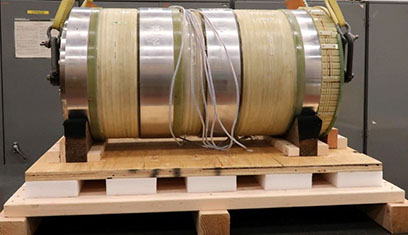
Campus Updates
Facility for Rare Isotope Beams
With civil construction of the project substantially complete, the focus at FRIB is now the installation of technical equipment. A key piece of equipment required for the heavy-ion beam was recently delivered to campus from California. FRIB partnered with the Berkeley Center for Magnet Technology (BCMT) at the Lawrence Berkeley National Laboratory (LBL) to design and build the state-of-the-art magnet.
Read more about this collaboration on the FRIB website.
Additional building projects planned at FRIB will include space for a new large-scale detector, as well as areas for isotope harvesting and an assembly area for equipment operating at hundreds of degrees below zero. Input from the campus community will be solicited during the planning process.
Technology Transfer Annual Recap
MSU was issued 51 U.S. patents in fiscal year 2017, as compared to 42 patents that were issued respectively in both FY16 and FY15. In addition to U.S. patents, Michigan State was also granted 32 foreign patents. Six start-up companies were launched, along with 159 student start-ups served in The Hatch. Additionally, $2.4M in royalties was distributed to our faculty and departments. Read more tech transfer news in the MSU Innovation Center Annual Report.
Global Impact Initiative
Michigan State University continues to welcome outstanding faculty to the university through the Global Impact Initiative. More than 70 new researchers have joined MSU over the past three years.
Recent hires include Marcia Gordon and David Morgan, top Alzheimer’s scholars from the University of South Florida. John Luginsland, an expert in computational plasma physics, previously served at the U.S. Air Force Office of Scientific Research. And Anna Moore, a radiologist from Harvard Medical, works with novel image-guided therapies for cancer treatment. Get to know more about GI2 faculty in this short video.
MSU and McLaren Health to Expand Partnership
McLaren Health announced in December that it will build a new $450 million hospital facility located in the University Corporate Research Park near Collins Road on the southwest side of campus. This represents numerous opportunities for collaborative research, clinical trials, recruitment of medical professionals, medical student training, and high-quality patient care for the community. Read the full news release.

MSU Contributes to Neutron Star Discovery
Last October, astronomers announced the collision of two neutron stars–the first ever observed–and Michigan State University contributed to this substantial discovery.
After the initial detection, numerous observatories joined the search, including the Southern Astrophysical Research telescope, (SOAR), located in Cerro Pachon, Chile. It is operated by the U.S. National Optical Astronomy Observatory for the SOAR consortium, of which MSU is a founding member. SOAR was one of 70 observatories that contributed to this research, and the documentation developed by the team was critical for understanding the evolution of the source.
Jay Strader, assistant professor, Department of Physics and Astronomy, was co-author of one of the papers confirming the discovery, and Arash Bahramian, research associate, contributed to the research.
According to Strader, “SOAR is positioned prominently to perform follow-up work well into the next decade.” SOAR will provide research opportunities for our faculty and students, as well as researchers around the world. Read more about this discovery.
Faculty Awards
Many MSU faculty have been recognized for their research and creative endeavors over the past semester, and below is a selection of those announcements. I urge you to read our Faculty Awards page where we curate award stories from across campus. Please be sure to send us your news for inclusion at research@msu.edu.

Besley Elected to AAAS
John Besley, the Ellis N. Brandt Chair in Public Relations and associate professor in the Department of Advertising and Public Relations, has been named a Fellow of the American Association for the Advancement of Science, or AAAS. Besley was elected as an AAAS Fellow for his distinguished contributions to the field of science communication and the study of public opinion about science and technology. He has also been instrumental in developing the new research communication workshops being conducted for faculty here on campus.

Lin Receives NSF Early Career and DOE Awards
Huey-Wen Lin, assistant professor in the Department of Physics and Astronomy, was recently awarded a five-year National Science Foundation Early CAREER award and a 2017 Advanced Scientific Computing Research (ASCR) Leadership Computing Challenge (ALCC) award from the U.S. Department of Energy (DOE). Lin was selected for the Early CAREER Award under the NSF’s Division of Physics for her research, “Constraining Parton Distribution Functions for New-Physics Searches,” which aims to understand nucleon structure through the development and implementation of first-principles calculations using supercomputers. Lin is also the principal investigator of a project that received a 2017 ALCC award from the DOE at ASCR’s supercomputing facilities.

McCusker Named MSU Foundation Professor
Professor James McCusker, Department of Chemistry, and director of MSU’s Center of Research Excellence in Complex Materials is the latest researcher to be named an MSU Foundation Professor. McCusker’s research focuses on ultrafast excited-state dynamics of transition metal compounds, particularly how they relate to the development of solar energy conversion strategies based on earth-abundant materials. His research group also studies the photophysics and photochemistry of exchange-coupled compounds, with an eye toward understanding electronic structure effects on electron and energy transfer processes in molecular systems. McCusker was named a Fellow of the Royal Society of Chemistry last fall, illustrating the global reach of research being conducted by our faculty and their graduate students.
Grant Preparation Support
NSF Application Guide Update
The National Science Foundation (NSF) recently released a revised version of the Proposal & Award Policies & Procedures Guide (PAPPG), version 18-1. Below are some notable policy changes for your review. Please note, these changes were effective for proposals submitted, or due, on or after January 29, 2018. For the complete PAPPG, please review the NSF’s summary of changes and visit the MSU Office of Sponsored Programs NSF Sponsor page for additional information.
- Proposal – Project Description: The Project Description has been modified to reflect that the description must now contain a separate section specifically identified as “Intellectual Merit”.
- Proposal – Budget Justification: The page limitation has been increased from three pages to five pages with additional justifications needed.
- Collaborators & Other Affiliations (COA) Information: The COA information must be provided through the use of the NSF COA template. This information is used to manage reviewer selection.
OVPRGS Grant Proposal Services
Our team offers a number of grant writing, editing, and peer review services. Visit the proposal prep to learn more or contact one of our consultants, and be sure to join our mailing list to receive notices on upcoming lectures, workshops, and other grant support events.
Interdisciplinary Forums
OVPRGS, along with the MSU Center for Interdisciplinarity, periodically hosts informal, late afternoon events to showcase ongoing faculty research. The motivation for these events is to form new collaborations for possible research projects and proposal submission. Visit the forum page to learn about upcoming events or submit a topic for consideration.
Reminder: Conflict of Interest
Annual Conflict of Interest disclosures are due for many faculty, as the previous deadline was annually in February. If you have not completed your conflict of interest disclosure in the past twelve months, please do so now. Information on how to complete your annual disclosure can be found on the COI website.
